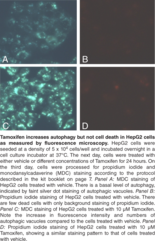服务热线
021-60498804
产品中心
/ Products Classification 点击展开+
| Cat. Number | 066225153676617 |
||||||||||||||||||
| Chemical Name | Autophagy/Cytotoxicity Dual Staining Kit |
||||||||||||||||||
| References |
Background ReadingJin, S., and White, E. Tumor suppression by autophagy through the management of metabolic stress. Autophagy 4(5) 563-566 (2008). Munafó, D.B., and Colombo, M.I. A novel assay to study autophagy: Regulation of autophagosome vacuole size by amino acid deprivation. J Cell Sci 114 3619-3629 (2001). Niemann, A., Takatsuki, A., and Elsässer, H. The lysosomotropic agent monodansylcadaverine also acts as a solvent polarity probe. J Histochem Cytochem 48(2) 251-258 (2000). Mizushima, N., Levine, B., Cuervo, A.M., et al. Autophagy fights disease through cellular self- Levine, B., and Kroemer, G. Autophagy in the pathogenesis of disease. Cell 132 27-42 (2008). Show all 5 Hide all but first 3
Description
Autophagy is a critical cellular process that involves the degradation and digestion of intracellular components by the lysosome. This process not only enables cells to efficiently mobilize and recycle cellular constituents, but also prevents the accumulation of damaged organelles, misfolded proteins, and invading microorganisms.1 Autophagy is a multi-
1 Jin, S., and White, E. Tumor suppression by autophagy through the management of metabolic stress. Autophagy 4(5) 563-566 (2008). 2 Levine, B., and Kroemer, G. Autophagy in the pathogenesis of disease. Cell 132 27-42 (2008). 3 Munafó, D.B., and Colombo, M.I. A novel assay to study autophagy: Regulation of autophagosome vacuole size by amino acid deprivation. J Cell Sci 114 3619-3629 (2001).
4
Mizushima, N., Levine, B., Cuervo, A.M., et al. Autophagy fights disease through cellular self- 5 Niemann, A., Takatsuki, A., and Elsässer, H. The lysosomotropic agent monodansylcadaverine also acts as a solvent polarity probe. J Histochem Cytochem 48(2) 251-258 (2000). |
||||||||||||||||||





